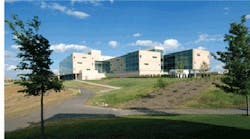Great River Energy, an electric generation and transmission cooperative serving the Upper Midwest, opened the doors of its headquarters in Maple Grove, Minn., to members of the trade press April 16, showcasing the first building in Minnesota to be certified Platinum under Version 2.2 of the U.S. Green Building Council’s Leadership in Energy and Environmental Design for New Construction and Major Renovations Green Building Rating System.
The event, co-sponsored and co-hosted by Tate Access Floors Inc., included presentations by Russell Philstrom, LEED AP, CDT, of architectural firm Perkins + Will, Dale J. Holland, PE, LEED AP, of engineering firm Dunham Associates Inc., and Joe Hassenfritz of general contractor McGough Construction, as well as a tour of the year-old facility.
As Great River Energy President and Chief Executive Officer David Saggau explains in a white paper detailing the planning, design, and construction of the facility: “We wanted to build a state-of-the-art building in energy efficiency, sustainability, and conservation that includes at least one innovative design feature that has never been done before. We wanted the building to contribute to the advancement of sustainable green building and be an educational tool for others to see how easily—and relatively inexpensively—these technologies could be applied. We wanted our commitment to renewable energy to be visible to even the most casual passerby. Last but not least, we wanted to dispel the notion that energy efficiency and conservation mean sacrificing beauty, functionality, or practicality. Finally, we wanted our building to be a place people want to visit and a building that employees love coming to every day.”
Designed to use approximately 50-percent less energy than a comparable facility built to state code requirements and approximately 90-percent less water than a similarly sized corporate campus, the four-story, 166,000-sq-ft building includes a 200-kw wind turbine and 72 kw of solar panels. At the heart of the building’s efficiency, however, are daylight harvesting and what Great River Energy believes may be a first: the combination of lake-source geothermal heating and cooling with underfloor displacement ventilation.
Nontoxic, biodegradable propylene glycol is mixed with water and pumped through 34 miles of ¾-in. high-density polyethylene pipe coiled at the bottom of nearby Arbor Lake. The closed-loop system works with 70 heat pumps to extract heat from the building during summer and absorb heat from the lake during winter.
Raised floors allow air to be delivered by in-floor diffusers located throughout the building. Air is supplied at floor level at 65°F to 68°F and vented at the ceiling at approximately 80°F. Airflow is driven by natural convection. The building was designed to provide 10-percent more outdoor air and 30-percent more fresh air to the breathing zone than required by ANSI/ASHRAE Standard 62.1-2004, Ventilation for Acceptable Indoor Air Quality.
The cost of the building with all of its energy-efficiency measures was less than 10-percent more than the cost of a conventional corporate headquarters of the same size.
Keeping Score
Great River Energy’s headquarters received 56 points under Version 2.2 of the U.S. Green Building Council’s Leadership in Energy and Environmental Design for New Construction and Major Renovations Green Building Rating System, four more than required for Platinum certification. How it accomplished the feat:Sustainable Sites. Great River Energy received 12 of 14 possible points in this category in part by building on a previously developed site within a half-mile of 10 basic services and a quarter-mile of two or more public bus lines, planting native or adapted vegetation on more than half of the site area, implementing a stormwater-management plan, employing a thermal-polyolefin white roof, and lighting areas for safety, security, and navigation without impacting the night sky or adjacent properties. Water Efficiency. Great River Energy received all five possible points in this category in part by collecting rainwater for use in toilets and urinals and installing low-flow aerators and motion sensors on bathroom faucets and dual flush meters on toilets.
Energy & Atmosphere. Great River Energy received 16 of 17 possible points in this category by demonstrating a more-than-47.5-percent improvement in energy performance compared with a baseline building complying with ANSI/ASHRAE/IESNA Standard 90.1-2004, Energy Standard for Buildings Except Low-Rise Residential Buildings; deriving approximately 14 percent of its energy from on-site renewable sources (about 10 percent from the wind turbine and 3 to 5 percent from the solar panels); employing enhanced commissioning for all systems; selecting refrigerants that contribute little, if at all, to ozone depletion and global warming; and receiving 100 percent of its electricity from renewable sources.
Materials & Resources. Great River Energy received six of 13 possible points in this category by recycling more than 95 percent of construction waste; using a variety of materials made from recycled content; using a variety of materials extracted, processed, and manufactured regionally; and using Forest Stewardship Council-certified wood.
Indoor Environmental Quality. Great River Energy received 13 of 15 possible points in this category in part by installing permanent monitoring systems that provide feedback on ventilation-system performance; using low-emitting adhesives and sealants, paints and coatings, carpet systems, and composite wood and agrifiber products; providing individual task-lighting and comfort controls; and providing a view of the outside to more than 90 percent of occupants.
Innovation & Design Process. Great River Energy received four of five possible points in this category in part by allowing employees and guests to interact with building information through kiosks in the lobby and at www.greatriverenergy.com.












